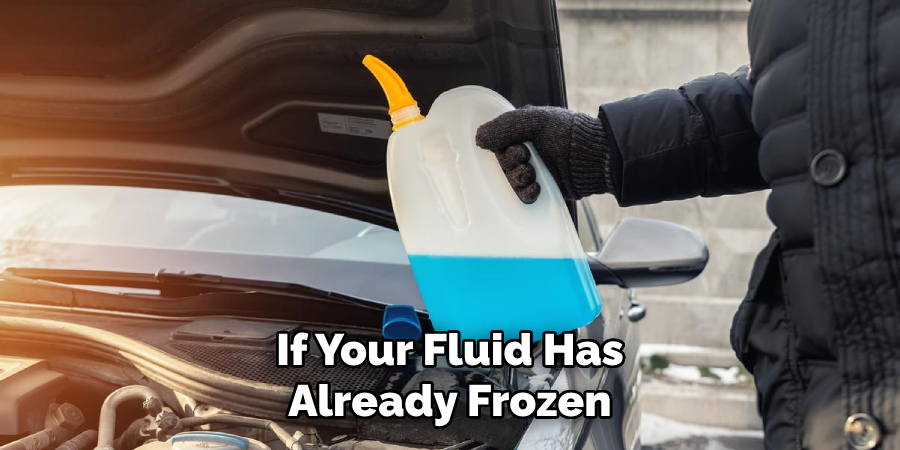How To Thaw Frozen Windshield Washer Fluid

Frozen windshield washer fluid is a common winter woe that can severely impair visibility and pose a safety hazard. Addressing this issue requires a blend of caution and knowledge. This article provides a detailed guide on how to safely and effectively thaw frozen windshield washer fluid, catering to everyone from the everyday car owner to experienced mechanics.
Understanding Why Washer Fluid Freezes
Before delving into thawing methods, it's crucial to understand why washer fluid freezes in the first place. Standard summer washer fluid formulations often lack sufficient antifreeze protection. These fluids are typically water-based with detergents, and their freezing point is close to that of water (0°C or 32°F). Winter-specific washer fluids, on the other hand, contain higher concentrations of alcohol (typically methanol or isopropanol) to lower the freezing point significantly. Using the wrong type of fluid is the primary cause of freezing.
Another contributing factor can be a clogged or malfunctioning washer fluid reservoir. If the pump is struggling to circulate fluid, even winter-grade fluid can freeze in the lines or nozzles, especially during prolonged exposure to sub-freezing temperatures.
Safe and Effective Thawing Methods
Several methods can be employed to thaw frozen windshield washer fluid. However, it's imperative to prioritize safety and avoid methods that could damage your vehicle.
1. Garage or Warm Environment Thawing
The safest and often most effective method is to move your vehicle into a heated garage or a warmer environment. The ambient heat will gradually thaw the fluid. This process can take several hours, depending on the severity of the freeze. Ensure the garage is well-ventilated. Running the car inside, even with the garage door open, can lead to dangerous carbon monoxide buildup. Let the car sit, and periodically check the fluid reservoir. Once the fluid is thawed, test the system by activating the windshield washers.
2. Using a Hair Dryer (with extreme caution)
A hair dryer can be used to gently warm the washer fluid reservoir and lines. Important: Keep the hair dryer moving constantly and at a safe distance from plastic components. Avoid concentrating heat on any single area for extended periods, as this can melt or warp plastic parts. Never use a heat gun, as its intense heat can easily cause damage. This method is best suited for thawing partially frozen systems or lines, rather than a completely frozen reservoir.
3. Diluting with Concentrated Washer Fluid (After Partial Thawing)
If the fluid is only partially frozen, you can attempt to dilute it with concentrated winter-grade washer fluid. First, try to manually break up any ice chunks in the reservoir. Then, carefully add the concentrated fluid. The higher alcohol content will help lower the overall freezing point. This method works best when the freezing isn't severe. It's also crucial to ensure you have enough space in the reservoir to add the concentrated fluid without overflowing.
4. Professional Assistance
If the above methods fail or if you're uncomfortable working on your car, it's best to seek professional assistance. A mechanic can safely thaw the system using specialized equipment and diagnose any underlying issues, such as a faulty washer pump or clogged lines. They can also properly drain the system and refill it with the correct winter-grade fluid.
Methods to Avoid (Important!)
Certain methods are highly discouraged as they can cause significant damage to your vehicle:
- Pouring Hot Water: This is a common mistake. The sudden temperature change can crack the plastic washer fluid reservoir or even the windshield.
- Using Antifreeze Directly: Adding pure engine antifreeze to the washer fluid reservoir is extremely dangerous. Antifreeze is highly toxic and can damage the washer pump and lines. Furthermore, it's not designed for cleaning windshields and can leave a greasy residue.
- Forcing the Washer Pump: Repeatedly trying to activate the frozen washer pump can burn out the motor. This will require a costly replacement.
Preventing Future Freezing
Prevention is always better than cure. To prevent frozen windshield washer fluid, take the following precautions:
- Use Winter-Grade Washer Fluid: Always use winter-grade washer fluid with a freezing point appropriate for your local climate. Check the temperature rating on the bottle.
- Drain and Refill: Before winter arrives, drain any remaining summer washer fluid from the reservoir and refill it with winter-grade fluid.
- Check Washer Nozzles: Ensure the washer nozzles are clear and unobstructed. Clogged nozzles can contribute to freezing. Use a needle or fine wire to clear any blockages.
- Regularly Test the System: Test the washer fluid system periodically during the winter to ensure it's functioning correctly.
By understanding the causes of frozen windshield washer fluid and employing safe thawing techniques, you can ensure clear visibility and safe driving throughout the winter months. Remember to prioritize safety and seek professional help when needed. Using the proper winter-rated fluid is the best defense against freezing.
